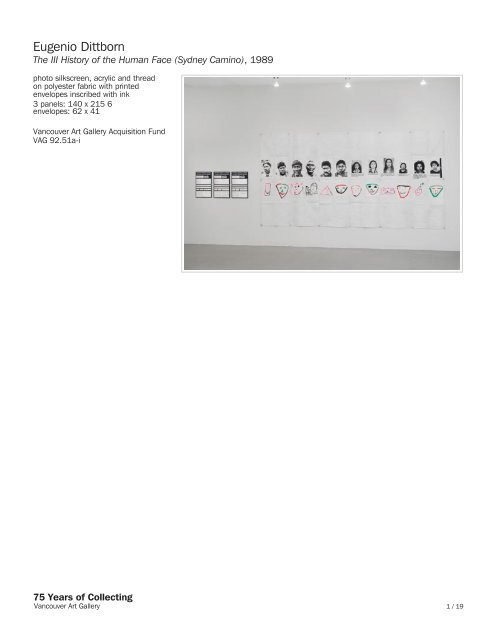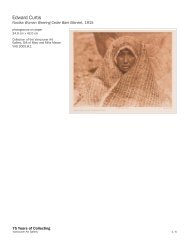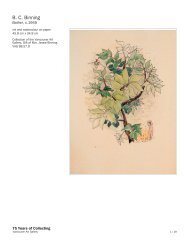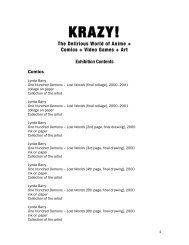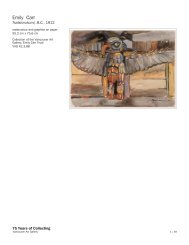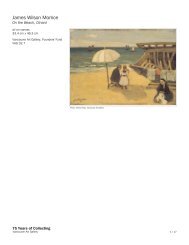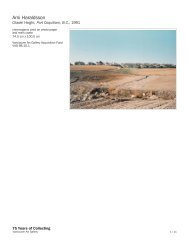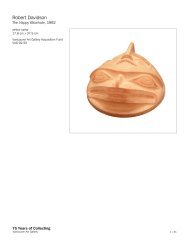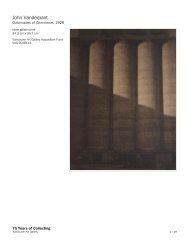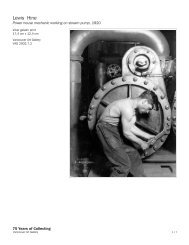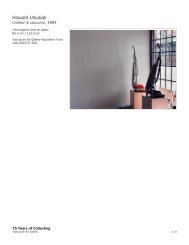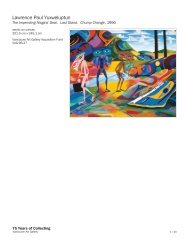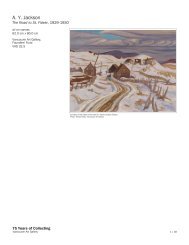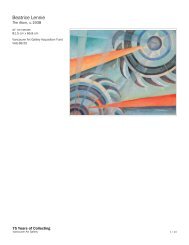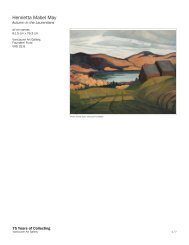Eugenio Dittborn - 75 Years of Collecting - Vancouver Art Gallery
Eugenio Dittborn - 75 Years of Collecting - Vancouver Art Gallery
Eugenio Dittborn - 75 Years of Collecting - Vancouver Art Gallery
You also want an ePaper? Increase the reach of your titles
YUMPU automatically turns print PDFs into web optimized ePapers that Google loves.
<strong>Eugenio</strong> <strong>Dittborn</strong><br />
The III History <strong>of</strong> the Human Face (Sydney Camino), 1989<br />
photo silkscreen, acrylic and thread<br />
on polyester fabric with printed<br />
envelopes inscribed with ink<br />
3 panels: 140 x 215 6<br />
envelopes: 62 x 41<br />
<strong>Vancouver</strong> <strong>Art</strong> <strong>Gallery</strong> Acquisition Fund<br />
VAG 92.51a-i<br />
<strong>75</strong> <strong>Years</strong> <strong>of</strong> <strong>Collecting</strong><br />
<strong>Vancouver</strong> <strong>Art</strong> <strong>Gallery</strong><br />
1 / 19
<strong>Eugenio</strong> <strong>Dittborn</strong><br />
The III History <strong>of</strong> the Human Face (Sydney Camino), 1989<br />
<strong>75</strong> <strong>Years</strong> <strong>of</strong> <strong>Collecting</strong><br />
<strong>Vancouver</strong> <strong>Art</strong> <strong>Gallery</strong><br />
<strong>Art</strong>ist's Biography<br />
Nationality: Chilean<br />
Born: 1943, Santiago, Chile<br />
<strong>Eugenio</strong> <strong>Dittborn</strong> has a significant international presence as a leading Latin<br />
American artist who has been featured in numerous international group<br />
exhibitions. From the Chilean capital <strong>of</strong> Santiago where they originate, <strong>Dittborn</strong>'s<br />
Airmail Paintings have traveled via international post to exhibition venues<br />
worldwide since 1983. Initially working under the isolation <strong>of</strong> the military<br />
dictatorship in Chile, <strong>Dittborn</strong> found a way to disguise his artwork, bypass the<br />
bureaucratic system and engage in the activities <strong>of</strong> the international art world by<br />
sending his items to galleries around the world. He silkscreens, paints,<br />
photographically prints and embroiders onto inexpensive, lightweight fabric and<br />
then folds the material for travel in cardboard airmail envelopes. The itineraries<br />
<strong>of</strong> each are written onto the envelopes which are displayed along with the<br />
unfolded work. The journeys, the distances spanned and the strategies uses to<br />
communicate are very much part <strong>of</strong> the work.<br />
The subjects <strong>of</strong> the Airmail Paintings also address and make visible a variety <strong>of</strong><br />
experiences that are forgotten or suppressed by <strong>of</strong>ficial histories. Alongside<br />
authoritative sources, such as police records or historical photographs, <strong>Dittborn</strong><br />
adds personal imagery, such as a photograph <strong>of</strong> his newborn daughter or<br />
images from mass media, such as a newspaper transcript <strong>of</strong> a woman's tale <strong>of</strong><br />
surviving an earthquake. The artist says that his work is "a way <strong>of</strong> salvaging my<br />
previous work, which was threatened, like every other cultural production in Chile<br />
in these last years, with oblivion. Power in our country constructs a social,<br />
political and cultural space which is characterized by a monstrous capacity to<br />
empty and exclude any possibility <strong>of</strong> memory. My artistic work puts itself<br />
forward, in its travels, as a little model <strong>of</strong> a possible memory." The Airmail<br />
Paintings specifically produce alternative perspectives to Chile's history <strong>of</strong><br />
colonial rule, Pinochet's dictatorship, and its current society, but the work also<br />
connects with contemporary art movements that recover the complexity <strong>of</strong> local<br />
histories and give voice to suppressed perspectives. His subtle political critique<br />
is all the more powerful because the works have a delicate, vulnerable and<br />
transitory quality similar to the information they convey.<br />
<strong>Art</strong>istic Context<br />
Nationality: Chilean<br />
Training: Escuela de Bellas <strong>Art</strong>es <strong>of</strong> the Universidad de Chile, Santiago; Escuela<br />
de Fotomecánica, Madrid; Hochschule für Bildende Kunst, Berlin; École des<br />
Beaux-<strong>Art</strong>s, Paris<br />
Peers: Cildo Meireles; Gonzalo Diaz; <strong>Art</strong>uro Duclos<br />
Group: screenprinting; Correspondence <strong>Art</strong>; 20th century; 21st century<br />
Provenance: the artist<br />
Subject: Chilean history and political culture; supressed histories; found imagery<br />
2 / 19
<strong>Eugenio</strong> <strong>Dittborn</strong><br />
The III History <strong>of</strong> the Human Face (Sydney Camino), 1989<br />
<strong>75</strong> <strong>Years</strong> <strong>of</strong> <strong>Collecting</strong><br />
<strong>Vancouver</strong> <strong>Art</strong> <strong>Gallery</strong><br />
Other Works in the <strong>Vancouver</strong> <strong>Art</strong> <strong>Gallery</strong> Collection<br />
Euqenio <strong>Dittborn</strong><br />
La XI Historia del Rostro (500 anos)—Airmail Painting No. 91, 1991<br />
paint, stitching, photo screenprint and envelopes on non-woven fabric<br />
Gift <strong>of</strong> Lloyd's <strong>of</strong> London<br />
VAG 99.41 a-u<br />
Bibliography<br />
Out <strong>of</strong> Place<br />
Publication<br />
1993<br />
[transcription]<br />
"Many were caught sleeping and awake in another world. Others who woke up<br />
suddenly, were locked in more by their own confusion than by any lack and key,<br />
or because they couldn't find the key, they were buried by falling walls or<br />
suffocated by the dust. Miraculously, many found refuge in the midst <strong>of</strong> the<br />
worst danger, because as the walls collapsed to the outside, they were saved by<br />
the woodwork, which sheltered them between the spaces, creating a vault."<br />
P. Diego de Rosale<br />
"The planet is full <strong>of</strong> collective apparitions, like Canada, Brazil, the Swiss Congo,<br />
and the Common Market."<br />
Jorge Luis Borges, 19<strong>75</strong><br />
Conversations<br />
between <strong>Eugenio</strong> <strong>Dittborn</strong> born<br />
and Roberto Merino<br />
(1989-1990)<br />
Wednesday, 11 October, 1989<br />
RM One <strong>of</strong>ten speaks—in relation to your work—about a certain precariousness<br />
<strong>of</strong> means, about your having given up the pretence <strong>of</strong> expensive ostentation in<br />
works which are, after all, <strong>of</strong> large format. In a catalogue, Pablo Oyarzún talks<br />
about "a kind <strong>of</strong> financial indisposition." It seems to me that this precariousness<br />
is a basic structural feature, an element that goes without saying: it is in the<br />
subtext, not an issue <strong>of</strong> content. I even think there might be a certain identity<br />
between precariousness and necessity. I'm talking about a principle <strong>of</strong> necessity<br />
<strong>of</strong> means and techniques. In this way, precariousness, which is also a<br />
constituent feature <strong>of</strong> our national life, is cited in your work, if not explicitly.<br />
ED Various things occur to me, for example, you might understand the<br />
precariousness in my work as the fact that the elements which are connected<br />
are provisionally connected. If, for example, you stick one piece <strong>of</strong> non-woven<br />
fabric over another, you can” unstitch it, unstick it, pull it apart. None <strong>of</strong> the<br />
means I use to stick things together allows you to do it definitively. So, that is<br />
what the provisional character <strong>of</strong> the inscriptions is about, and therefore, <strong>of</strong> the<br />
connections.<br />
3 / 19
<strong>Eugenio</strong> <strong>Dittborn</strong><br />
The III History <strong>of</strong> the Human Face (Sydney Camino), 1989<br />
<strong>75</strong> <strong>Years</strong> <strong>of</strong> <strong>Collecting</strong><br />
<strong>Vancouver</strong> <strong>Art</strong> <strong>Gallery</strong><br />
RM Therefore, the meaning <strong>of</strong> the work is an issue in parenthesis ...<br />
ED In a condition in which you can keep on making comments about the<br />
meaning, and go on dedlaying [delaying] a conclusion, not intending any<br />
definitive meaning.<br />
RM So, we could apply the word "precariousness," which I was lust using, to<br />
this.<br />
EDThe precarious is something which can fall or be taken to pieces at any given<br />
moment, something provisional, and therefore transitory.<br />
RM Another issue that interests me very much, that I even find quite beautiful,<br />
and which I feel must be one <strong>of</strong> the essential points <strong>of</strong> emotion (or <strong>of</strong> tension) in<br />
your work, is this: how the journey, or its motif, or the motif <strong>of</strong> travel, is<br />
inscribed, without explicit indication, in the unspoken elements <strong>of</strong> the work.<br />
First, in the selection <strong>of</strong> material (non-woven fabric), which requires certain<br />
conditions for packing and sending, and then, in the fact <strong>of</strong> the folds, which I<br />
have related to the cracking <strong>of</strong> Duchamp's Large Glass.<br />
ED Which is a sign <strong>of</strong> travel.<br />
RM An intervention <strong>of</strong> chance.<br />
ED Maybe it's the early intervention <strong>of</strong> destiny. An accidental encounter that<br />
leaves a mark.<br />
RM In the Airmail Paintings, the folds are not innocent marks because they are<br />
signs that are meant to be exhibited in the unfolding.<br />
The printed and stitched faces contained in the 11th History <strong>of</strong> the Human Face<br />
are: 19 mugshots <strong>of</strong> chilean men and women thieves published in a criminology<br />
magazine <strong>of</strong> the thirties, found by <strong>Dittborn</strong> fourteen years ago in Santiago, Chile;<br />
I6 faces <strong>of</strong> aborigines from Tierra del Fuego, the southernmost region <strong>of</strong> South<br />
America (Selknam, Yamana and Alakawulup tribes) photographed by Martin<br />
Gusinde, a German anthropologist who lived among them, in the twenties, faces<br />
that <strong>Dittborn</strong> found in 41 book written by Gusinde.<br />
From the inscription written by <strong>Eugenio</strong> <strong>Dittborn</strong> on one envelope for The<br />
11th History <strong>of</strong> the Human Face (500 years) 1991<br />
ED In epic poetry, oil the intermediate destinations that the hero arrives<br />
at—before getting to the end—are the result <strong>of</strong> the intervention <strong>of</strong> all those<br />
forces trying to prevent the hero from arriving at his final destination (destiny?):<br />
the Sirens, the Cyclops, Cerberus; these are the obstacles. So, in the case <strong>of</strong><br />
the Large Glass, it was the mark <strong>of</strong> the obstacles; it was as though the<br />
obstacles left their mark. Now, with the Airmail Paintings, it is the reverse: these<br />
marks—the folds—are precisely what makes transit possible, they are the<br />
condition <strong>of</strong> possibility for transit.<br />
RM Turning to other things, what relation is there between the faces which<br />
appear in The 6th History <strong>of</strong> the Human Face? That is to say, between the<br />
child's pre-pictorial drawing, the police sketch or identikit, the ID photo, the<br />
4 / 19
<strong>Eugenio</strong> <strong>Dittborn</strong><br />
The III History <strong>of</strong> the Human Face (Sydney Camino), 1989<br />
<strong>75</strong> <strong>Years</strong> <strong>of</strong> <strong>Collecting</strong><br />
<strong>Vancouver</strong> <strong>Art</strong> <strong>Gallery</strong><br />
photographs <strong>of</strong> Indians, the faces from how-todraw books, and those taken from<br />
anonymous drawings, found in diaries, notebooks, magazines.<br />
ED To find faces that are at a maximum distance from one another. A certain<br />
vertigo is produced by these abysses, these jumps from one face to the next,<br />
from one technique to another, and between the different places in which I<br />
found each face. So that as each Airmail Painting travels, there are journeys<br />
within the work itself: the enormous distances between one face and the next.<br />
Antipodes abruptly placed into contact.<br />
RM When I was referring earlier to emotion, I was talking about the way in which<br />
that abyss is cited, how that abyss <strong>of</strong> travel is on unspoken port <strong>of</strong> the work<br />
itself.<br />
ED Like a lateral phenomenon.<br />
RM Like something implicitly understood. And the emotion is in that possibility<br />
<strong>of</strong> something that is beyond the signs inscribed in the work to be read and<br />
decoded.<br />
ED One could talk about the emotion <strong>of</strong> the folds.<br />
RM Or about the excitement <strong>of</strong> the canvas. Do you remember that we once<br />
talked about the English word "canvas"—which is used for a painting on (canvas)<br />
linen, for the soil <strong>of</strong> a boot, and also for the floor <strong>of</strong> the boxing ring?<br />
What are you working on at this precise moment?<br />
ED I'm going to start working with a hanged man by Goyo, one <strong>of</strong> the Capriccios,<br />
called "Hunting for Teeth." It shows a woman who is stealing the gold fillings out<br />
<strong>of</strong> the hanged man's mouth, covering her nose with o[a] handkerchief, because<br />
he is completely putrefied, but she is intent on getting out those gold fillings.<br />
One could speak <strong>of</strong> a gold peculiar to excluded places. One <strong>of</strong> the things that<br />
runs through all visual experimentation is the search for gold, in remote places.<br />
And what is most intensely sought after in this practice is, precisely, the glint <strong>of</strong><br />
it in unlikely places. I think that the voyage <strong>of</strong> the Airmail Paintings reformulates<br />
the entire question <strong>of</strong> gold. By displacing it, gold is suddenly devalued.<br />
RM By transferring it publicly.<br />
ED By making it go from hand to hand at the risk <strong>of</strong> being lost.<br />
Monday, 16 October, 1989<br />
RM Your work, which crosses space, also freely crosses time and its signs. One<br />
might say that from moments in time that are more or less remote—1976,<br />
1977—a system <strong>of</strong> references in transformation has been unfolding, a selfreferential<br />
history. In your work neither the idea <strong>of</strong> fashion nor the idea <strong>of</strong><br />
progress exists, nor even the need—pathetic, because one always likes to<br />
dissimulate—to be up-to-date. I have the impression that this attitude is driven<br />
by a general concept <strong>of</strong> work.<br />
5 / 19
<strong>Eugenio</strong> <strong>Dittborn</strong><br />
The III History <strong>of</strong> the Human Face (Sydney Camino), 1989<br />
<strong>75</strong> <strong>Years</strong> <strong>of</strong> <strong>Collecting</strong><br />
<strong>Vancouver</strong> <strong>Art</strong> <strong>Gallery</strong><br />
ED I would like to amplify your statement "In your work, the idea <strong>of</strong> fashion does<br />
not exist." It doesn't, it's true. The idea <strong>of</strong> fashion (moda) is not in my work. And<br />
yet, fashion is also there. Refashioned (modificada).<br />
RM A few years ago, they had to prohibit tourists from entering some <strong>of</strong> the<br />
ancient rock caves in France because the carbon dioxide <strong>of</strong> their exhalations<br />
was ruining the paintings. This was shown on television, on the Ripley program.<br />
On the other hand, a work made for posterity, like Leonardo's Last Supper lasted<br />
for centuries in the refectory where it was, resisting the onslaughts <strong>of</strong> damp in a<br />
place that was flooded for much <strong>of</strong> the time. Again, during the Napoleonic<br />
invasion, the French soldiers entertained themselves during their free time<br />
throwing stones at the heads <strong>of</strong> the Twelve Apostles. Centuries before, another<br />
work <strong>of</strong> Leonardo's, the giant clay horse that was the model for the bronze<br />
equestrian statue <strong>of</strong> Francesco Sforza, was also destroyed by French soldiers. It<br />
is very strange when the closed world <strong>of</strong> the work <strong>of</strong> art is invaded like<br />
this—inundated so violently by the everyday<br />
world. And it is also curious that dust—both domestic and metaphysical—should<br />
have painted itself over Rembrandt, turning the group portrait <strong>of</strong> the Night Watch<br />
into a nocturnal scene. I imagine that the Airmail Paintings have their defence<br />
systems, given that they are made to be placed in the exterior world, to be<br />
moved about and manipulated by it, and they even enter the international mail<br />
system—with its strikes, its delays, its negligence, and its hazards—and they<br />
survive.<br />
ED The fragility <strong>of</strong> the Airmail Paintings manages to pass through the entire<br />
international mail network, and the paintings invariably arrive on time, and in<br />
perfect condition at their destinations. What I am trying to say here is that the<br />
mail is not only what you say it is (on strike, delayed, negligent, and full <strong>of</strong><br />
hazards), but it is also the complete opposite: expeditious, efficient, and<br />
humorous—it always makes the automatic joke <strong>of</strong> carrying the Airmail Paintings<br />
to their destination and then the superior joke <strong>of</strong> returning them to the sender.<br />
To put it another way, the Airmail Paintings travel in envelopes. These host<br />
them, hide them, carry them. They accredit them, certify them, and send them<br />
on their way. What can you say about an Airmail Painting asleep in an envelope<br />
at 0315, local time in the airport at Papeete, Tahiti, in the interior <strong>of</strong> a Boeing<br />
belonging to Quantas or UTA or LanChile, while here in Santiago it is 2015 <strong>of</strong><br />
the previous day and in Noumea, the capital <strong>of</strong> New Caledonia, and the next<br />
landing point <strong>of</strong> that Airmail Painting on its way to Sydney, it is 1215 <strong>of</strong> the<br />
following day?<br />
Once the trip is finished, the receiver at the destination opens the envelopes,<br />
the paintings are unfolded, they are hung on the walls, and are exhibited along<br />
with the envelopes. And then, in this moment, the entire trajectory actually<br />
takes place: by being suspended. Like the blood which pours from a cut.<br />
RM People are talking so much about marginalization, in every possible area,<br />
and your work presents an enormous gallery <strong>of</strong> marginal figures: muggers, petty<br />
thieves and swindlers, pickpockets, victims, aborigines. We are in a very<br />
complicated territory here, and a delicate one as well, because in trying to<br />
recuperate marginal figures one is always in danger <strong>of</strong> recreating a power<br />
relation in which the artist would be—at the least—more protected by the sort<br />
<strong>of</strong> security inherent in his/her strange social position. In your case, you have<br />
specific ways—in the choice <strong>of</strong> faces for example—<strong>of</strong> avoiding the scientist's<br />
arrogance or the romantic's fetishism. We've talked about how in your work what<br />
is restored is more a relationship between power and the subject.<br />
6 / 19
<strong>Eugenio</strong> <strong>Dittborn</strong><br />
The III History <strong>of</strong> the Human Face (Sydney Camino), 1989<br />
<strong>75</strong> <strong>Years</strong> <strong>of</strong> <strong>Collecting</strong><br />
<strong>Vancouver</strong> <strong>Art</strong> <strong>Gallery</strong><br />
ED By citing police photos <strong>of</strong> criminals and delinquents <strong>of</strong> the 1930s, 1940s,<br />
and 1950s in my work, I've tried to explore a specific and contractory<br />
relationship: the collision between the police camera, the<br />
camera that is properly the power <strong>of</strong> the state working visually, and the faces <strong>of</strong><br />
small-time Chilean criminals, men and women who are, mostly, transplanted<br />
and impoverished peasants. The visual document <strong>of</strong> this collision is a<br />
photograph which, along with the name, the false names, all the aliases, certain<br />
physical characteristics, and brief biographical notes, etc., makes up the dossier<br />
<strong>of</strong> the subject photographed. Such records were published in El Detective, a<br />
criminology and police science magazine, published by the Bureau <strong>of</strong><br />
Investigation between about 1925 and 1950. What marginality can you speak<br />
<strong>of</strong> when dealing—in the case <strong>of</strong> the police records in question—not with faces in<br />
their outcast and extraterritorial immediacy, but instead with the photographic<br />
plates annexed to penal records, all <strong>of</strong> this produced by the state in order to<br />
exercise control over and over again?<br />
Putting it another way, might it not be marginality itself that the power <strong>of</strong> the<br />
state robs from these robbers? Without the margin or the centre, they end up<br />
inhabiting and acting, paradoxically, in the only space they have left: the photos<br />
in their files. They are the photos in their files. I have not been well understood<br />
on this point. I have not been working with marginal criminals but with the<br />
petrified and precise instant <strong>of</strong> their subordination by the power—the<br />
photographic power—<strong>of</strong> the state and its printed multiplication. Isn't this instant<br />
also the abrupt modernization <strong>of</strong> the face <strong>of</strong> the underworld?<br />
Saturday, 18 November, 1989<br />
RM It is important to try to specify the role that the receiver has with respect to<br />
the Airmail Paintings, the subject who scans the paintings and who at some<br />
moment must feel his gaze making contact with the others—with the printed<br />
ones (the eyes, for example, <strong>of</strong> the criminals and the aborigines who appear in<br />
the Histories <strong>of</strong> the Human Face). It's really impressive the way those printed<br />
eyes, those signs <strong>of</strong> the one who is looking, connect with the gaze <strong>of</strong> the<br />
spectator. What is reproduced, what is enlarged an the surface <strong>of</strong> the synthetic<br />
fabric is a photograph, and, as such, is also a suspended relation in an instant<br />
<strong>of</strong> time between that face and the camera that confronted it. That suspended<br />
situation—in the moment <strong>of</strong> the unfolding and the exhibition—comes to<br />
completion.<br />
ED Exactly. It is because <strong>of</strong> this that there are light years between the gaze <strong>of</strong><br />
those who arrive printed and that <strong>of</strong> the receivers in different places around the<br />
world.<br />
RM Also, there would be the "airmailness" <strong>of</strong> the gaze. These printed gazes are<br />
equivalent to the fossilized light—the light that reaches us from the stars long<br />
after they have been extinguished—that you have sometimes mentioned.<br />
ED Yes, they are. The criminals keep looking at the camera <strong>of</strong> the state, but<br />
neither they nor the camera exist any longer: their looks continue travelling, but<br />
they are no longer looking.<br />
RM And these gazes carry on, changing their vehicles: from the magazines to<br />
the Airmail Paintings.<br />
7 / 19
<strong>Eugenio</strong> <strong>Dittborn</strong><br />
The III History <strong>of</strong> the Human Face (Sydney Camino), 1989<br />
<strong>75</strong> <strong>Years</strong> <strong>of</strong> <strong>Collecting</strong><br />
<strong>Vancouver</strong> <strong>Art</strong> <strong>Gallery</strong><br />
ED An Airmail Painting is the space in which these times meet one another. In<br />
this scene, the hybridization in my work is a temporal hybridization. Signs that<br />
belong to different and distant temporal strata finally meet there, and in<br />
meeting, make one another reciprocally visible. This also has to do with<br />
mediation, that is, with that which makes transfer possible and which travels in<br />
order to transfer particular questions. For example, in the Pieta the first<br />
mediation would be the TV screen on which erupted the image <strong>of</strong> Benny Kid<br />
Paret lying in agony on the canvas at Madison Square Garden. A UPI<br />
photographer photographed the scene from the TV screen, and later the UPI<br />
sent this photo to the Chilean magazine Gol y Gol which printed and published<br />
it. A copy <strong>of</strong> this magazine ended up 15 years later in a secondhand bookstore<br />
where I found it in 1977. I worked for a relatively long time with this photograph,<br />
reprinting it many times. Finally, in the last six years I have used this same photo<br />
in a few <strong>of</strong> the Airmail Paintings. I have a special fascination with images that<br />
carry the traces <strong>of</strong> their successive transfer or signs <strong>of</strong> their travels, as we have<br />
already seen. The figure <strong>of</strong> Benny Kid Paret, dying from the punches <strong>of</strong> Emile<br />
Griffith, was contained on the TV screen, and then a photograph contained the<br />
agonized figure <strong>of</strong> Benny Kid Paret televised. Finally, a magazine printed and<br />
published the multimedia-ized figure <strong>of</strong> the Cuban boxer. That is the model: in<br />
the object itself are visibly, visually inscribed, all the mediations that contained<br />
and transferred it: all its layers.<br />
RM I wanted to go back to the issue <strong>of</strong> the photo encountered in a magazine.<br />
There is nothing else possible, nothing other than dispatching this found object<br />
in order to maintain it as such. The Airmail Painting is not, however, an ultimate<br />
destination. Things come together in it, make themselves seen, and at the same<br />
time, have to continue circulating.<br />
ED Sure, it is as if it was a punishment. This is how they seem.<br />
RM Like a penance ...<br />
ED The penance is to be permanently in movement.<br />
RM Like souls that have no resting place.<br />
ED They have no house and no destiny. All destinations are the house.<br />
RM There is another issue I would like to discuss, which is the following. In the<br />
text for the catalogue to your exhibition at the Australian Centre for Photography<br />
in Sydney (October 1989), the Airmail Paintings are described as "evading the<br />
imperatives <strong>of</strong> the art market ... [they] arrive to unfold and to occupy a<br />
substantial amount <strong>of</strong> the hotly contested space <strong>of</strong> the cultural metropolis."<br />
Now, this question is an important one: how by means <strong>of</strong> airmailness can one<br />
totally avoid that sort <strong>of</strong> pyramid <strong>of</strong> desires and fantasies that accompany the<br />
exhibition <strong>of</strong> one's actual works in the metropolis? In other words, the way in<br />
which your painting converts the metropolis into a place <strong>of</strong> transit, since from<br />
there it is soon sent on to another place <strong>of</strong> transit, giving the metropolis a status<br />
equivalent to the place <strong>of</strong> origin. The metropolis is no longer the place <strong>of</strong> arrival,<br />
the supreme summit <strong>of</strong> the artist's career.<br />
8 / 19
<strong>Eugenio</strong> <strong>Dittborn</strong><br />
The III History <strong>of</strong> the Human Face (Sydney Camino), 1989<br />
<strong>75</strong> <strong>Years</strong> <strong>of</strong> <strong>Collecting</strong><br />
<strong>Vancouver</strong> <strong>Art</strong> <strong>Gallery</strong><br />
ED This is very much to the point, what you're saying, and I think you are<br />
absolutely right. I want to add that the Airmail Paintings, so small in their<br />
envelopes, deceive the agents <strong>of</strong> the metropolis. They say: "Is it a letter? Yes,<br />
that's what it is. It's a bit big, but go ahead, no problem."<br />
RM Dealing with letters, there is no problem at all.<br />
ED It's the idea <strong>of</strong> the Trojan Horse. These guys say: OK, it's a letter. And when<br />
you open it, unfold it, and hang it, the Airmail Paintings effectively come "to<br />
occupy a substantial amount <strong>of</strong> the hotly contested space <strong>of</strong> the cultural<br />
metropolis."<br />
RM A part <strong>of</strong> the vital space <strong>of</strong> the metropolis.<br />
ED So, probably, what is specific about the Airmail Paintings is that they are a<br />
ruse, as the poets say. What's the ruse? It's that the Airmail Paintings are<br />
paintings disguised as letters. For this reason they can infiltrate. In this sense<br />
they have a viral character. They work with a viral notion <strong>of</strong> war.<br />
RM What would be the opposite <strong>of</strong> the viral war?<br />
ED The opposite to the viral war would be the declaration <strong>of</strong> war. Because<br />
viruses don't declare war.<br />
RM They just start it.<br />
ED It's not only that they start the war, but that they start it retrospectively.<br />
[laughter] Yes, and then, when the Airmail Paintings come back, the agents <strong>of</strong><br />
the metropolis say "Aaggh, it's too late." [more laughter]<br />
Sunday, 11 February, 1990<br />
RM Today, what is your current project?<br />
ED An exhibition called Transcontinental, which will include nine Latin American<br />
artists: six Brazilians, an Argentinean, Juan Domingo Dávilo, and me, and which<br />
is opening in a month and a half, simultaneously, in the Ikon <strong>Gallery</strong> in<br />
Birmingham and the Cornerhouse in Manchester, England.<br />
RM Have you been working on anything special for the exhibition?<br />
ED Yes, there were lots <strong>of</strong> possibilities. In the end, I viewed them as<br />
complementary to one another and not alternatives. One possibility was to have<br />
works that had already circulated arrive at the exhibition.<br />
RM That would have embraced their transit points, their itineraries.<br />
9 / 19
<strong>Eugenio</strong> <strong>Dittborn</strong><br />
The III History <strong>of</strong> the Human Face (Sydney Camino), 1989<br />
<strong>75</strong> <strong>Years</strong> <strong>of</strong> <strong>Collecting</strong><br />
<strong>Vancouver</strong> <strong>Art</strong> <strong>Gallery</strong><br />
ED That's right. Another option was an Airmail Painting with a more or less long<br />
itinerary, or maybe a work that would be a dispatch to England, the fact that its<br />
destination was England would be taken into consideration. My contribution<br />
actually includes works like Pietà from 1985, which has already had 14 stops,<br />
and which is there basically to show what I've been doing for the past five years.<br />
But again, the notion <strong>of</strong> "what I've been doing" is problematic, because we're<br />
talking, <strong>of</strong> course, about a painting<br />
68 E 06 EN 0 D ITIBORN<br />
that has been circulating for five years. That is to say, the works are not merely<br />
finished in the studio, but begin their voyage in the mail and continue on from<br />
there.<br />
RM Yes, I see. It's curious, but it's precisely the transitoriness...<br />
ED It's as though the Rod had been in the process <strong>of</strong> "being sent", in some way<br />
or another, from 1985 to 1990. Something like those apparatuses <strong>of</strong> NASA that<br />
travel for six or seven years before getting to a very remote point in outer space.<br />
And there is one work that was especially made for England (for the<br />
Cornerhouse in Manchester), which is a type <strong>of</strong> work that has no prior itinerary<br />
and which has been made especially for its first stop. Works that,<br />
nevertheless—like all the Airmail Paintings—in having a specific destination,<br />
work out or develop that destiny (destination?) from within. Of what would this<br />
consist? That some <strong>of</strong> the figures in this work should be protagonists <strong>of</strong> some<br />
history that includes both Chile and England, through an aboriginal from Tierra<br />
del Fuego like Jemmy Button (who was taken to London in 1829), or through<br />
connections between frozen figures, like the mummy <strong>of</strong> the El Plomo mountain,<br />
and John Torrington (an English sailor who died in the disastrous expedition <strong>of</strong><br />
Sir John Franklin and who remained frozen for 130 years in a place near the<br />
North Pole), and then again, there's the mask that my sister Alejandro was<br />
bringing to me as a gift, when she died during her return trip from Africa in<br />
1989. This mask would be, in some way, the model <strong>of</strong> something that<br />
theoretical physicists call "fossil light."<br />
RM Which we've already mentioned....<br />
ED We talked about it in another context. According to what I've recently read<br />
about the mummy <strong>of</strong> El Plomo, the boy who ultimately became the mummy<br />
walked approximately twelve kilometers to the place <strong>of</strong> his sacrifice. Always<br />
upward. And this has been deduced from the marks found on his feet, because<br />
the mummy still has a number <strong>of</strong> blisters on his feet, a quantity <strong>of</strong> marks from<br />
his shoes, a shoe which was a ceremonial shoe, a shoe that was slightly too<br />
small for his foot. And this shoe was continually hurting him the whole way up. It<br />
is, also, like the Duchampian thing that we saw at the beginning: a sign <strong>of</strong><br />
travel. One can deduce the trajectory, calculate the distance that the mummy<br />
was made to walk by the marks on the mummified skin <strong>of</strong> this nine-year-old Inca<br />
child. And there's another thing that is fascinating about freezing or mummifying.<br />
That is, here you have a dead body that is, at the same time, completely intact.<br />
The Niño del Plomo and John Torrington, the British sailor, are<br />
10 / 19
<strong>Eugenio</strong> <strong>Dittborn</strong><br />
The III History <strong>of</strong> the Human Face (Sydney Camino), 1989<br />
<strong>75</strong> <strong>Years</strong> <strong>of</strong> <strong>Collecting</strong><br />
<strong>Vancouver</strong> <strong>Art</strong> <strong>Gallery</strong><br />
very important, I think, to my work—not only because they represent a similar<br />
fate as frozen bodies, but because they permit access to particular experiences,<br />
both personal and collective, that have been arrested. That is, they have not<br />
been allowed to dissolve, in the sense that they have not been allowed to<br />
deteriorate, and they are still pending or suspended and conserved. These<br />
frozen bodies are a variant <strong>of</strong> fossilization and embalmment.<br />
RM So, now what are you working on specifically for Manchester? Are you going<br />
back to working with Jemmy Button?<br />
ED Yes, in To Travel, Travelled, Travelled, Travelling. The figure <strong>of</strong> Torrington also<br />
appears in this work, as well as the mask that my sister brought back from Africa<br />
and the mummy <strong>of</strong> the Cerro El Plomo. The work also includes Chilean and<br />
English newspapers from January 31, 1990.<br />
RM Newspapers <strong>of</strong> the some date?<br />
ED They are from the day I turned 41. They were purchased both here and<br />
there. There are a variety <strong>of</strong> things <strong>of</strong> a temporal order that are synchronized in<br />
the work. There's the date that Button left and the date he came back (1829-<br />
1834). Then, there is the date that they discovered Torrington two years ago<br />
(having been frozen for 138 years), and then the date the 1,450-year-old pre-<br />
Colombian mummy was discovered (1962); and then there's this recent thing,<br />
which is the arrival <strong>of</strong> the mask that Alejandro bought for me (1989); and there<br />
is the day <strong>of</strong> my birthday. I referred to it in our conversation <strong>of</strong> Saturday,<br />
November 18, 1989 when I said that the hybridization in my work was <strong>of</strong> a<br />
temporal kind and that signs come together that belong to different and widely<br />
separated strata <strong>of</strong> time. They encounter each other in the Airmail Painting and<br />
make one another visible, reciprocally.<br />
Roberto Merino is a poet who lives and works in Santiago de Chile.<br />
The conversations were translated by Claudia Rousseau.<br />
Mapa<br />
Publication<br />
1993<br />
[transcription <strong>of</strong> excerpt]<br />
11 / 19
<strong>Eugenio</strong> <strong>Dittborn</strong><br />
The III History <strong>of</strong> the Human Face (Sydney Camino), 1989<br />
<strong>75</strong> <strong>Years</strong> <strong>of</strong> <strong>Collecting</strong><br />
<strong>Vancouver</strong> <strong>Art</strong> <strong>Gallery</strong><br />
Further Reading<br />
Brett, Guy. Transcontinental. Birmingham and Cornerhouse, Manchester: Verso<br />
in association with Ikon <strong>Gallery</strong>, 1990.<br />
La Cuisine et la Guerre: Seven Airmail Paintings. Houston: Blaffer <strong>Gallery</strong>, the<br />
<strong>Art</strong> Museum <strong>of</strong> the University <strong>of</strong> Houston, 2001.<br />
<strong>Eugenio</strong> <strong>Dittborn</strong>: In an Instant and with Davestating Fury, 4 New Airmail<br />
Paintings. Miami: Centre for Fine <strong>Art</strong>s, 1993.<br />
From Another Periphery: 10 Airmail Paintings. Sydney: <strong>Art</strong>space, 1984.<br />
Paschal, Huston and Linda Johnson Dougherty. Defying Gravity: Contemporary<br />
<strong>Art</strong> and Flight. Raleigh: North Carolina Museum <strong>of</strong> <strong>Art</strong>, 2003.<br />
Philippi, Desa. "Distance <strong>of</strong> memory: the Airmail Paintings <strong>of</strong> <strong>Eugenio</strong> <strong>Dittborn</strong>,"<br />
Parachute: Contemporary <strong>Art</strong> Magazine. 83 (1996): 14-19<br />
Witness. North <strong>Vancouver</strong>: Presentation House <strong>Gallery</strong>, 1993.<br />
Zamudio, Raúl. "<strong>Eugenio</strong> <strong>Dittborn</strong>," <strong>Art</strong>Nexus. 54.3 (2004): 155-156.<br />
Exhibition History<br />
Exhibitions at the <strong>Vancouver</strong> <strong>Art</strong> <strong>Gallery</strong><br />
Out <strong>of</strong> Place. October 23, 1993 - January 17, 1994.<br />
Classified Materials: Accumulations, Archives, <strong>Art</strong>ists. September 24, 2005 -<br />
January 2, 2006.<br />
<strong>75</strong> <strong>Years</strong> <strong>of</strong> <strong>Collecting</strong>: Portrait <strong>of</strong> a Citizen. September 23, 2006 - January 1,<br />
2007.<br />
Selected Exhibitions Outside <strong>of</strong> the <strong>Vancouver</strong> <strong>Art</strong> <strong>Gallery</strong><br />
Austrialian Centre for Photography, Sydney. <strong>Eugenio</strong> <strong>Dittborn</strong>: Transperiferia.<br />
1989.<br />
Havana, Cuba. III Bienale de la Habana. 1989.<br />
12 / 19
<strong>Eugenio</strong> <strong>Dittborn</strong><br />
The III History <strong>of</strong> the Human Face (Sydney Camino), 1989<br />
<strong>75</strong> <strong>Years</strong> <strong>of</strong> <strong>Collecting</strong><br />
<strong>Vancouver</strong> <strong>Art</strong> <strong>Gallery</strong><br />
Archival History<br />
Acquisitions Justification<br />
Acquisition Record<br />
1992<br />
[transcription]<br />
<strong>Dittborn</strong>, <strong>Eugenio</strong><br />
b. 1943, Santiago, Chile<br />
The III History <strong>of</strong> the Human Face (Sydney Camino)1989<br />
Photo silkscreen acrylic and thread on polyester fabric with<br />
printed envelopes inscribed in ink<br />
three panels: 140 x 215 cm each<br />
three envelopes 62 x 41 x 1.5 cm each<br />
Vendor: The <strong>Art</strong>ist<br />
<strong>Eugenio</strong> <strong>Dittborn</strong> lives and works in Santiago, Chile. His work is being exhibited<br />
widely in exhibitions such as Trans-Continental - Nine Latin American <strong>Art</strong>ists in<br />
Birmingham and Manchester in 1990, the 4th Havana Bienal held in Cuba in<br />
1991 and most recently, he exhibited in DOCUMENTA IX. In 1993, Dittbom will<br />
have major solo exhibitions at Witte de With in Rotterdam and the Institute <strong>of</strong><br />
Contemporary <strong>Art</strong>, London.<br />
Since 1984, <strong>Dittborn</strong> has engaged in producing what he describes as Airmail<br />
Paintings. These works generally comprise multiple parts, They are produced on<br />
synthetic non-woven material, a material usually used as an inner-liner for<br />
padding mattresses or clothes. On the surface he paints, silkscreens,<br />
photographically prints and <strong>of</strong>ten stitches or embroiders. Each sheet is then<br />
folded and placed into its specifically designed envelope and sent via airmail to<br />
its place <strong>of</strong> exhibition. On their arrival they are taken out, unfolded, and hung<br />
with their shipping envelopes. The envelopes hung alongside the paintings list<br />
the chronology <strong>of</strong> the paintings previous journeys and exhibition history.<br />
<strong>Dittborn</strong>'s Airmail Paintings are, on one level, strategies he has adopted to<br />
enable his<br />
works participate in a cultural dialogue beyond Chile. Using minimal resources<br />
and<br />
working at what can be referred to as a cultural periphery, his works are easily<br />
transported and able to make strong visual statements from a fragile and<br />
transitory<br />
material base. <strong>Dittborn</strong> is interested in the fact that the transportation <strong>of</strong> works<br />
<strong>of</strong> act is usually ignored with more attention placed on exhibitions. <strong>Dittborn</strong>'s<br />
Airmail Paintings endeavour to bring forward the experience <strong>of</strong> the journey and<br />
evoke other journeys and memories. He works from found imagery and the<br />
resources he has accumulated throughout his life. In The III History <strong>of</strong> the<br />
Human Face, you have images from widely different social sources including<br />
mug shots, and excerpts from drawings produced by his daughter, Margarita. He<br />
combines them on a folded surface to produce unexpected and moving<br />
experiences. <strong>Dittborn</strong> himself, referring to The Airmail Paintings, links the<br />
enormous journeys and the tremendous gulfs within the interior <strong>of</strong> the work by<br />
linking the disparate images which he feels are parallels to the recorded<br />
notations <strong>of</strong> the paintings as they have travelled throughout the world.<br />
<strong>Dittborn</strong> <strong>Eugenio</strong> P. 2<br />
<strong>Dittborn</strong>'s work comes out <strong>of</strong> a period <strong>of</strong> intense activity by an artistic avant-<br />
13 / 19
<strong>Eugenio</strong> <strong>Dittborn</strong><br />
The III History <strong>of</strong> the Human Face (Sydney Camino), 1989<br />
<strong>75</strong> <strong>Years</strong> <strong>of</strong> <strong>Collecting</strong><br />
<strong>Vancouver</strong> <strong>Art</strong> <strong>Gallery</strong><br />
garde in Latin America which began in the mid 1960’s. His work <strong>of</strong>ten takes<br />
uppolitical themesand can be seen as developing upon the imperative set forth<br />
by Brazilian artist,HelioOiticica who wrote <strong>of</strong> the "necessity <strong>of</strong> complete participation<br />
by the poet, theartist the intellectual in general, in the events and problems<br />
<strong>of</strong> theworld refusing to restrict oneself to aesthetic problems.”<br />
<strong>Dittborn</strong> has produced an extended series on the History <strong>of</strong> he Human Face and<br />
The III History <strong>of</strong> the Human Face (The Sydney Camino) is a very good example.<br />
This work has been exhibited at the 4th Havana Bienal in Cuba as well as in<br />
Sydney, Australia. It is <strong>of</strong>ten not realized how Latin American artists embrace<br />
strategies that we think <strong>of</strong> as our own. In his case a conceptually based phototext<br />
practice. I feel that the addition <strong>of</strong> this work to the collection would join<br />
with works by Ian Wallace, Mary Kelly, Christian Botanski, Angela<br />
Graverholz, Thomas Ruff, Arnaud Maggs and others, each <strong>of</strong> which address the<br />
questions <strong>of</strong> history and identity, many <strong>of</strong> which use portraits. His work adds<br />
breadth to our ability to represent this important area <strong>of</strong> focus for artists<br />
throughout the past two decades.<br />
Recommend purchase.<br />
Gary Dufour<br />
Senior Curator<br />
Oct.1992<br />
Transcription<br />
Miscellaneous History<br />
1992<br />
[transcription]<br />
Transcription <strong>of</strong> texts written on <strong>Eugenio</strong> <strong>Dittborn</strong>'s III History <strong>of</strong> the<br />
Human Face Envelopes<br />
Envelope No: 67 Right<br />
UNA PINTURA AEROPOSTAL DE DITTBOAN<br />
AN AIRMAIL PAINTING BY DITTBORN<br />
DESTINATARIO/ DESTINATION FRANQUEO/POSTAGE<br />
Gary Dufour, <strong>Vancouver</strong> <strong>Art</strong> <strong>Gallery</strong><br />
<strong>75</strong>0 Hornby Street, <strong>Vancouver</strong><br />
British Columbia V6Z 2H7, Canada<br />
ITINERARIO I ITINERARY<br />
1. E, <strong>Dittborn</strong><br />
Stgo., Chile, May 89.<br />
2. Denise Robinson<br />
Sydney Australia, June 89.<br />
3. III Bienal de la Habana,<br />
14 / 19
<strong>Eugenio</strong> <strong>Dittborn</strong><br />
The III History <strong>of</strong> the Human Face (Sydney Camino), 1989<br />
<strong>75</strong> <strong>Years</strong> <strong>of</strong> <strong>Collecting</strong><br />
<strong>Vancouver</strong> <strong>Art</strong> <strong>Gallery</strong><br />
La Habana, Cuba, Nov. 89<br />
4. Denise Robinson<br />
Sydney, Australia, March 90<br />
5. E. Dittbom<br />
Stgo., Chile May 90<br />
6. E. <strong>Dittborn</strong><br />
Stgo. Chile, July 92<br />
7.<br />
8.<br />
9.<br />
10.<br />
TITULO/TITLE<br />
The 111 History <strong>of</strong> the Human Face (The Sydney Camino)<br />
TECNICA/TECHNIOUE<br />
Painting and Photosilkscreen on 3 Fragments on Non Woven<br />
Fabric<br />
OBRA/WORK<br />
No 67 (Right)<br />
ANO/YEAR<br />
1989<br />
DIMENSIONES/ SIZE OF WORK<br />
420 x 200 cms<br />
TEXTO/TEXT<br />
In order to realize this work I asked Margarita to paint with red fluorescent paint<br />
some <strong>of</strong> the faces she had drawn some time ago in that small notebook which I<br />
kept in my studio.<br />
She used the human faces drawn in the notebook as a score. I would indicate to<br />
her which lace fro the notebook I wanted her to work on. Each face was in a<br />
compartment I was indicating to her. ( Airmail Paintings are compartmentalized<br />
because they are folded)<br />
An Airmail Interview, S. Cubitt — E. <strong>Dittborn</strong>, Camino Way, Stgo., Chile, 1991<br />
REMITENTE/SENDER<br />
<strong>Eugenio</strong> <strong>Dittborn</strong> Santa Rita 968, Santiago 12, Chile<br />
impresos punto color<br />
la casa, the letter, the house<br />
No. 67 (left)<br />
UNA PINTURA AEROPOSTAL DE DITTBORN<br />
AN AIRMAIL PAINTING BY DITTBORN<br />
DESTINATARIO/ DESTINATION FRANQUEO/POSTAGE<br />
15 / 19
<strong>Eugenio</strong> <strong>Dittborn</strong><br />
The III History <strong>of</strong> the Human Face (Sydney Camino), 1989<br />
<strong>75</strong> <strong>Years</strong> <strong>of</strong> <strong>Collecting</strong><br />
<strong>Vancouver</strong> <strong>Art</strong> <strong>Gallery</strong><br />
Gary Dufour, <strong>Vancouver</strong> Al <strong>Gallery</strong><br />
<strong>75</strong>0 Hornby Street, <strong>Vancouver</strong><br />
British Columbia V6Z 2H7, Canada<br />
ITINERARIO /ITINERARY<br />
1. E, <strong>Dittborn</strong><br />
Stgo., Chile, May 89.<br />
2. Denise Robinson<br />
Sydney Australia, June 89.<br />
3. III Bienal de la Habana,<br />
La Habana, Cuba, Nov. 89<br />
4. Denise Robinson<br />
Sydney, Australia, March 90<br />
5. E. Dittbom<br />
Stgo., Chile May 90<br />
6. E. <strong>Dittborn</strong><br />
Stgo. Chile, July 92<br />
7.<br />
8.<br />
9.<br />
10.<br />
TITULO/TITLE<br />
The III History <strong>of</strong> the Human Face (Sydney Camino)<br />
TECNICA/TECHNIQUE<br />
Painting and Photosilkscreen on 3 Fragments on Non Woven Fabric<br />
OBRA/WORK<br />
No 67 (left)<br />
AÑO/YEAR<br />
1989<br />
DIMENSIONES/ SIZE OF WORK<br />
420 x 200 cms<br />
TEXTO/TEXT<br />
Margarita <strong>Dittborn</strong> was seven years old when we started, she and 1, working<br />
together in the first Histories <strong>of</strong> the Human Face (January, 1989). Three or four<br />
months before I had given Margarita a template with which she could draw basic<br />
geometrical figures (rhomboids, rectangles, circles, squares and triangles). With<br />
this template Margarita drew several figures in a notebook. Later on she added<br />
eyes, ears, nose and mouth to those shapes, producing the most extraordinary<br />
faces I kept this notebook ith the human faces in my studio.<br />
An Airmail Interview, S. Cubitt — E. <strong>Dittborn</strong><br />
Camino Way, Stgo., Chile, 1991<br />
16 / 19
<strong>Eugenio</strong> <strong>Dittborn</strong><br />
The III History <strong>of</strong> the Human Face (Sydney Camino), 1989<br />
<strong>75</strong> <strong>Years</strong> <strong>of</strong> <strong>Collecting</strong><br />
<strong>Vancouver</strong> <strong>Art</strong> <strong>Gallery</strong><br />
REMITENTE/SENDER<br />
<strong>Eugenio</strong> <strong>Dittborn</strong> Santa Rita 968, Santiago 12, Chile<br />
impresos punto color<br />
la casa, the letter, the house<br />
<strong>Dittborn</strong> Fax<br />
Correspondence<br />
1992-07-10<br />
[transcription]<br />
SANTIAGO DE CHILE, JULY THE 10th, 1992.<br />
FROM EUGENIO DITTBORN TO GARY DUFOUR.<br />
DEAR GARY DUFOUR:<br />
1. THE TWO AIRMAIL PAINTINGS LEFT SANTIAGO TO THE VANCOUVER ART<br />
GALLERY. LYON CARGO-THE COURIER THAT IS TRANSPORTING THEM-TOLD ME<br />
THAT THEY WERE GOING TO BE AT THE GALLERY ON MONDAY THE 13th OF<br />
JULY, 92. IT WOULD BE GOOD IF YOU USE THE SAME LYON CARGO TO SEND<br />
THEM BACK TO ME.<br />
2. YOU SHOULDN’T BE DAUNTED, AS YOU SAY, BY THE COST OF 1.480<br />
AMERICAN DOLLARS. THE PACKING AND TRANSPORT OF TWO PAINTINGS OF<br />
420 X 210 CENTIMETERS ONE AND 280 X 210 CENTIMETERS THE OTHER,<br />
BETWEEN SANTIAGO AND VANCOUVER AND THEN VANCOUVER AND SANTIAGO<br />
(ABOUT 26,000 KILOMTERS0, IS THE CHEAPEST ART TRANSPORT IN THE<br />
WORLD.<br />
AIR MAIL PAINTINGS INC. IS THE CHEAPEST ART TRANSPORT IN THE WORLD.<br />
THEREFORE YOU SHOULD BE DAUNTED BUT IN THE OTHER DIRECTION.<br />
I WOULD LIKE VERY MUCH TO TALK MORE ABOUT THAT POINT (TRANSPORT-$-<br />
PACKING-$). I THINK THAT ONE OF THE MOST IMPORTANT TRANSFORMATIONS<br />
PROPOSED BY THE AIR MAIL PAINTINGS IS PRECISELY THE ECONOMIC<br />
RELATION PRODUCED BETWEEN THE INSTITUTION THAT EXHIBIT THEM AND<br />
MYSELF.<br />
3. YOU HAVE TO KNOW, AS WELL, THAT THE PRICE OF THE ENVELOPES<br />
DEPEND ON THE AMOUNT OF ENVELOPES. 45 ENVELOPES, FOR INSTANCE, IS<br />
CHEAPER THAN TEN. I MEAN THAT THE PRICE PER UNIT IS CHEAPER.<br />
4. SO, THE INITIAL PHASE OF YOUR RESEARCH WILL BE OVER VERY SOON.<br />
SOME POINTS IN RELATION WITH THE UNFOLDING OF THE 2 AIR MAIL<br />
PAINTINGS: — EACH THIRD OF THE TRIPTYCH IS CONTAINED IN ONE<br />
ENVELOPE. THE LEFT FRAGMENT IS CONTAINED IN THE LEFT ENVELOPE. THE<br />
CENTRE FRAGMENT IN THE CENTRE ENVELOPE AND THE RIGHT FRAGMENT<br />
INTO THE RIGHT ENVELOPE. THE SAME FOR THE DIPTYCH. THIS SEEMS<br />
OBVIOUS BUT IT IS NOT; IF ONE DOESN’T KNOW WHICH IS THE ORDER OF<br />
DISPOSITION OF THE FRAGMENTS ONE MIGHT ARRANGE THEM IN THE WRONG<br />
WAY. THAT’S CLEAR IN THE SECTION OF THE ENVELOPES WHERE IT’S<br />
WRITTEN “OBRA/WORK No.”<br />
5. IF THE WORKS ARE GOING TO BE HANGED IN THE WALL THE WALL OR<br />
WALLS SHOULD BE DARKER THAN THE PAINTINGS. I ALWAYS USE WHAT I<br />
17 / 19
<strong>Eugenio</strong> <strong>Dittborn</strong><br />
The III History <strong>of</strong> the Human Face (Sydney Camino), 1989<br />
<strong>75</strong> <strong>Years</strong> <strong>of</strong> <strong>Collecting</strong><br />
<strong>Vancouver</strong> <strong>Art</strong> <strong>Gallery</strong><br />
HAVE CALLED AIR MAIL PAINTING GREY: 60% WHITE PLUS 40% BLACK. THIS<br />
COLOUR BEHIND THE AIR MAIL PAINTINGS PRODUCES ON THE SURFACES OF<br />
THE NON WOVEN FABRIC-THAT IS THEIR SUPPORT-WHAT I CALL THE MELTING-<br />
SNOW-EFFECT, THAT IS THE ACTIVE IRREGULARITY OF THE NON WOVEN<br />
INSTEAD OF THE ABSTRACT FLATNESS OF NON SUBSTANTIAL WHITE. (REREAD<br />
THE BEAUTIFUL FRAGMENT ABOUT THE NON WOVEN FABRIC WRITTEN ON PAGE<br />
6 OF CAMINO WAY BY BUY BRETT. (CENTRE OF THAT PAGE).<br />
IF THE WALLS ARE WHITE, THE MELTING-SNOW-EFFECT FADES. SO IF THE<br />
WALLS OF THE VANCOUVER ART GALLERY ARE WHITE, THE PAINTINGS SHOULD<br />
BE SEEN LYING ON THE FLOOR, CAREFULLY LYING ON THE FLOOR. BUT ON<br />
THE GROUND THEY WILL LOSE THEIR ENIGMA, THEIR VIRTUALITY AND THEIR<br />
FRAGILITY AND THAT IS NOT GOOD. IF YOU HANG THEM ON THE WALL<br />
DON’T STRETCH THEM HORIZONTALLY: THEY WOULD LOSE THEIR BELOVED<br />
FOLDS. AND THE FOLDS ARE SO BELOVED BECAUSE THEY ARE PROPERLY THE<br />
INTERSECTION OF THE AIRMAILNESS AND PAINTERNESS OF THE AIR MAIL<br />
PAINTINGS.<br />
6. YES. THIS IS REAL RESEARCH: THE ONE ABOUT AN OBJECT THAT IS<br />
WORKING AND ALIVE (WHILE I WRITE THIS FAX TO YOU AT MIDNIGHT THE TWO<br />
AIRMAIL PAINTINGS ARE FLYING TO CANADA AND I AM PREPARING WITH YOU<br />
THEIR ARRIVAL.)<br />
THEREFORE RESEARCH ABOUT WHAT AIR MAIL PAINTINGS DO AND NOT ABOUT<br />
WHAT AIR MAIL PAINTINGS ARE.<br />
WHEN YOU RECEIVE THE WORKS PLEASE SEND TO ME A FAX SAYING ARRIVED<br />
OR SOMETHING LIKE THAT. WELL, DEAR SENIOR CURATOR AND RESEARCHER,<br />
KIND REGARDS FROM DITTBORN AND I WANT YOU TO KNOW THAT MY<br />
COOPERATION IS ENTHUSIASTIC BECAUSE YOUR ENTHUSIASM IS VERY<br />
COOPERATIVE.<br />
CHAO, THEN!!<br />
Dufour Fax<br />
Correspondence<br />
1992-07-13<br />
[transcription]<br />
July 13, 1992<br />
<strong>Eugenio</strong> <strong>Dittborn</strong><br />
Santa Rita<br />
968 Santiago 12<br />
Chile<br />
Dear <strong>Eugenio</strong>,<br />
The Airmail Paintings travelled safely over the weekend and they are now in<br />
<strong>Vancouver</strong>. They are clearing customs now with Milne and Craighead and will be<br />
delivered to the gallery this afternoon. I am very keen to open them but I will<br />
wait to convene my colleagues to involve them in the act <strong>of</strong> receiving the Airmail<br />
Paintings.<br />
Your point about what Airmail Paintings DO rather than what they<br />
objectively ARE is crucial. I will lay the paintings out on a dark grey carpet and<br />
then they can be viewed from the mezzanine above. The mezzanine is about 18<br />
feet up so we should be able to see them to very good advantage with the<br />
"melting snow" effect.<br />
18 / 19
<strong>Eugenio</strong> <strong>Dittborn</strong><br />
The III History <strong>of</strong> the Human Face (Sydney Camino), 1989<br />
<strong>75</strong> <strong>Years</strong> <strong>of</strong> <strong>Collecting</strong><br />
<strong>Vancouver</strong> <strong>Art</strong> <strong>Gallery</strong><br />
Thank you,<br />
Sincerely,<br />
[signed Gary Dufour]<br />
Gary Dufour<br />
Senior Curator<br />
:am<br />
Terms and Conditions<br />
The images, texts, documentation, illustrations, designs, icons and all other<br />
content are protected by Canadian and international copyright laws. The content<br />
may be covered by other restrictions as well, including copyright and other<br />
proprietary rights held by third parties. The <strong>Vancouver</strong> <strong>Art</strong> <strong>Gallery</strong> retains all<br />
rights, including copyright, in data, images, text and any other information. The<br />
<strong>Gallery</strong> expressly forbids the copying <strong>of</strong> any protected content, except for<br />
purposes <strong>of</strong> fair dealing, as defined by Canadian copyright law.<br />
19 / 19


